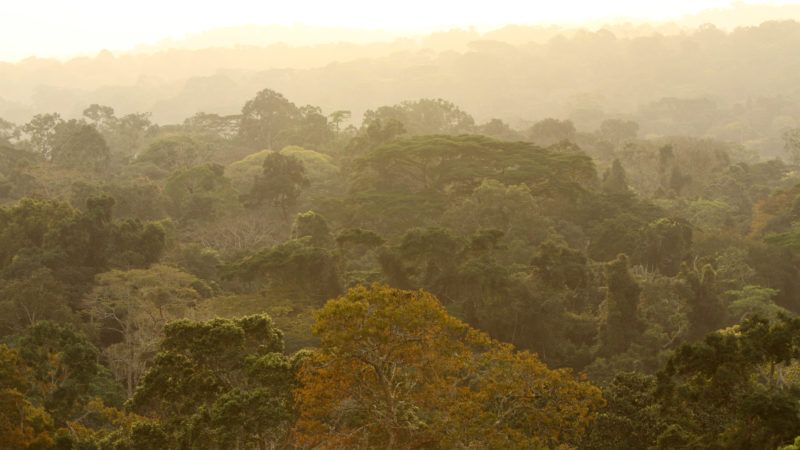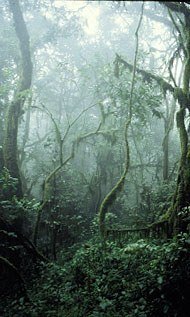Loss of sexual dimporhism is associated with loss of lekking behavior in the green manakin (Xenopipo holochora)
Published Work | 2015 | Journal of Avian Biology 46(3), 307–314
permalink
Research Project | 2016
Region:
Africa (Cameroon, Equatorial Guinea, Ivory Coast), Australia, South America (Ecuador)
These projects seek to understand the mechanisms important in generating rainforest biodiversity. Results from research on birds in Cameroon and reptiles in Australia strongly suggest that these transition zones, known as ecotones, are an important generator of the biodiversity of the rainforest. These findings have important implications for conservation policies, which to date have focused on the preservation of the rainforest exclusively, effectively seeking to preserve the pattern of biodiversity but not the process that creates it. By taking a multifaceted approach to the study of evolution, we can understand how diverging populations become new species, and take steps to conserve and protect those areas of the tropics that support such evolutionary processes.
With its collaborators, CTR has secured funding to expand this research to include birds, reptiles, small mammals and bats, in-and-around the rainforests of Africa, South America, and Australia. Finally, CTR is working with Senior Scientists at the Jet Propulsion Lab to utilize NASA satellite imagery to assess the degree of ecotone loss worldwide.


Related Publications
Published Work | 2015 | Journal of Avian Biology 46(3), 307–314
permalinkPublished Work | 2014 | Oryx 50(2), 302-307
permalinkPublished Work | 2014 | Biotropica 47(1), 6–17
permalinkPublished Work | 2014 | Applied Geography 53, 369–376
permalinkPublished Work | 2014 | Journal of Tropical Ecology 30(4), 273–290
permalinkPublished Work | 2013 | Biological Conservation 166, 203–211
permalinkPublished Work | 2013 | PLoS ONE 8(7)
permalinkPublished Work | 2013 | Proceedings of the Royal Society Biology 280(1763)
permalinkPublished Work | 2013 | PLoS ONE 8(5)
permalinkPublished Work | 2013 | Evolutionary Applications 6(6), 865–874
permalinkPublished Work | 2012 | Nature 489, 290–294
permalinkPublished Work | 2012 | PLoS ONE 7(7)
permalinkPublished Work | 2011 | Molecular Ecology 20(18), 4564–4576
permalinkPublished Work | 2011 | Evolution 65(11), 3162–3174
permalinkPublished Work | 2011 | Molecular Phylogenetics and Evolution 60(2), 207–218
permalinkPublished Work | 2011 | Biological Journal of the Linnean Society 103(4), 821–835
permalinkPublished Work | 2011 | Biological Journal of the Linnean Society 103(3), 696–706
permalinkPublished Work | 2010 | Ostrich 71, 269–276
permalinkPublished Work | 2010 | Global Change Biology 17(4), 1671–1680
permalinkPublished Work | 2010 | PLoS ONE 5(9)
permalinkPublished Work | 2010 | Molecular Ecology 19(17), 3532–3548
permalinkPublished Work | 2010 | Molecular Ecology 19(17), 3773–3788
permalinkPublished Work | 2010 | Evolutionary Applications 3(1), 1–16
permalinkPublished Work | 2009 | Conservation Genetic Resources 2, 205–208
permalinkPublished Work | 2009 | Behavioral Ecology 29, 1089–1095
permalinkPublished Work | 2009 | Molecular Ecology 18(14), 2979–2995
permalinkPublished Work | 2009 | Proceedings of the National Academy of Sciences 106, 8256–8261
permalinkPublished Work | 2007 | Molecular Phylogenetics and Evolution 43(3), 795–807
permalinkPublished Work | 2007 | Wilson Journal of Ornithology 119(2), 222–228
permalinkPublished Work | 2006 | The Auk 123(1), 119–134
permalinkPublished Work | 2005 | University of Chicago Press: Chicago, Chicago, USA, 148–165
permalinkPublished Work | 2005 | Molecular Ecology Notes 5(4), 849–850
permalinkPublished Work | 2005 | Journal of Biogeography 32, 1371–1384
permalinkPublished Work | 2005 | Biology Notes 2005, 5, 844–845
permalinkPublished Work | 2005 | Molecular Ecology Notes 5(4), 755–756
permalinkPublished Work | 2005 | Phylogeny and Conservation
permalinkPublished Work | 2004 | Journal of Evolutionary Biology 18(2), 257–268
permalinkPublished Work | 2002 | Evolution 56(9), 1849–1858
permalinkPublished Work | 2002 | Condor 104(3), 564–573
permalinkPublished Work | 2001 | Trends in Ecology and Evolution 16(8), 431
permalinkPublished Work | 2001 | American Journal of Primatology 54(2), 91–105
permalinkPublished Work | 2001 | Studies in Avian Biology 22, 194–201
permalinkPublished Work | 2001 | Genetica 112, 383–398
permalinkProgress Report | 2000
download pdf permalinkPublished Work | 2000 | Annual Reviews of Ecology and Systematics 31, 533–563
permalinkPublished Work | 1999 | roceedings of the National Academy of Sciences 96(24), 13869–13873
permalinkProgress Report | 1999
download pdf permalinkPublished Work | 1998 | Trends in Ecology and Evolution 13(12), 502–506
permalinkPublished Work | 1998 | Journal of Tropical Ecology 14(3), 351–371
permalinkPublished Work | 1997 | Science 276(5320), 1855–1857
permalinkProgress Report | 1996
download pdf permalinkPublished Work | 1996 | Molecular Genetic Approaches in Conservation 1-21
permalinkPublished Work | 1993 | Biodiversity Letters 1(6), 164–167
permalink